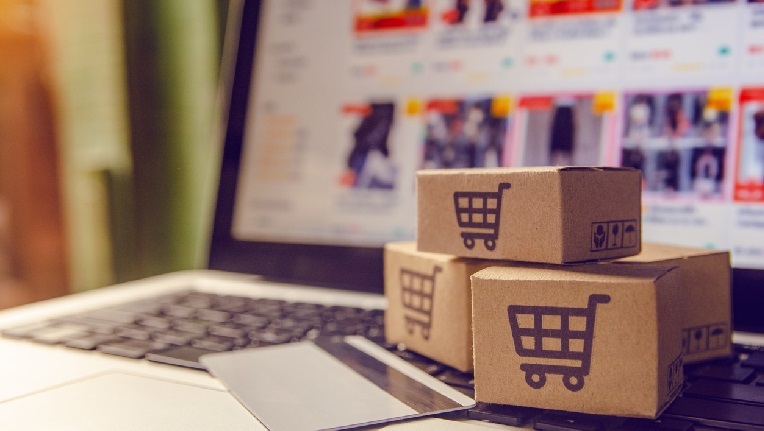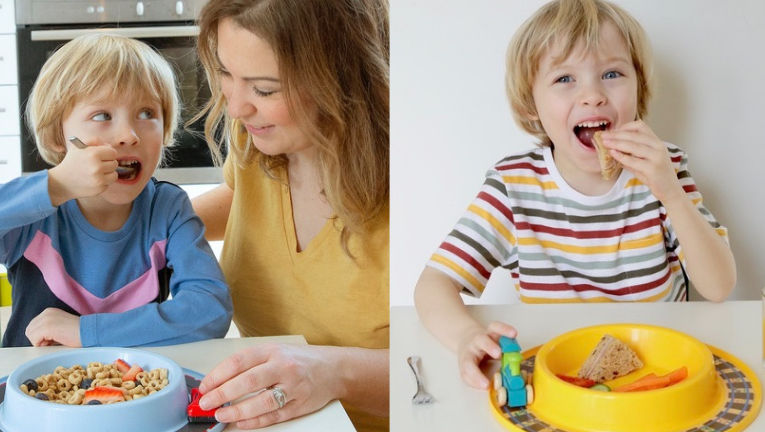A beginner's guide to selling online

Posted: Wed 27th Jan 2021
Want to be successful at selling products or services online? This guide outlines the key steps for getting started and free resources to access through the Amazon Small Business Accelerator e-learning programme.
Decide what to sell
You can sell pretty much anything online but it's important to have a strategy behind it. Ways to decide what to sell include thinking about what interests and hobbies you have. Is there something related that you could sell?
Or perhaps you've discovered a need that needs filling. If you've struggled to find a particular product or service, the chances are that lots of other people have too and you could provide it.
Enterprise Nation founder Emma Jones provides more advice on coming up with a business idea in this video as part of the Amazon Small Business Accelerator e-learning programme.
When thinking about which products to sell online, you should spend some time researching your potential customers and your competitors.
What types of people will buy your products? Where do they live? What's their gender? How old are they? Also look at where your potential competitors are selling their products or services. Check their prices and how they engage with customers.
The Amazon Small Business Accelerator e-learning programme provides more advice on researching customers and researching competitors.
Decide on your pricing
The right pricing is crucial to making a success of selling online and it is one of the biggest business decisions you'll make.
It's easy to underprice but ways to avoid it include looking at the prices of businesses that have a very similar business model to you and then working out how you intend to price your products or service. You might want to price in line with them, below them or above them as premium product.
You should also speak to your ideal customers. Rather than ask them if they'd pay a certain price, quiz them on their previous buying habits and how much they paid for a similar product or service. You then need to work out a price based on how much profit you want to make taking into account all your costs.
For more detailed advice on pricing, watch this e-learning video. Gosia Suchojad from Bunch Skincare viewed the video and said:
"The advice on choosing the right competitors to compare prices is really useful. Also, the tips on the importance of mindset and believing in the product are great. It helped me to understand how the correct pricing is the key to sustainable business.
"After watching the video, I reviewed the pricing of my products from the perspective of the value and benefit to customers."
Select a place to sell
Your own website
Having your own website is a great place to start selling. You could invest in a bespoke site but if budgets are tight, a template service such as those provided by GoDaddy, 123 Reg, WordPress or Squarespace can be highly effective.
Your website could be transactional and allow people to directly buy your products or services online, or a catalogue website which showcases your products or services and people buy them by getting in touch with you in some other way such as visiting a high-street shop or an online store like Amazon or eBay.
Make your site easy to use with simple navigation. Easy check out is essential and give customers choice for payment options. There are various payment options you can use including PayPal, Shopify, Square and Amazon Pay.
Give the customer as much information as possible about a product or service so they can determine if it's right for them. In an online setting, you don't have the luxury of a store assistant but you need to convey same levels of services.
Think about the product or service and what information someone needs before they click 'buy'. It can help to ask someone else to do this as you can be biased because you know your products or services so well.
It's a good idea to include a list of frequently asked questions on your website but also contact details for questions if needed.
There's excellent advice on turning online browsers into buyers in this e-learning video.
Online stores
You can sell your products to a wide audience in the UK and around the world using online stores that welcome third party sellers such as Amazon, Etsy, Not On The High Street and eBay.
Spend time researching which platform is right for your products. Look at what other types of products are already being sold and which are doing well for sales. Check the fees charged by the online stores, and look at what useful services they offer such as Fulfilment by Amazon, which handles the shipping for you.
Many also allow you to pay for advertising which means your products are promoted to your target customers.
Dominique Woolf, founder of Woolf's Kitchen, registered to sell her spicy sauces on Amazon's online store only a few months after her business launched. She said: "Amazon is crucial to food businesses. It enables me to reach potentially millions of customers I wouldn't be able to reach without being on there."
Watch e-learning videos on how to get started on Amazon's online stores here and using Amazon's marketing tool, Sponsored Products. You can also watch interviews with successful Amazon Selling Partners for inspiration.
Social media
Platforms like Instagram and Facebook are another way to sell products online. You can set up a Facebook shop or link directly to products on your Instagram page to encourage your social media followers to make purchases.
Be great at delivery and customer service
Delivery and customer service is a vital factor in being successful at selling online. Make sure you're clear about delivery times and whether or not customers have to pay for shipping.
Provide an easy way for customers to get in touch if there are any problems. You may want to include the cost of postage is your price so delivery costs aren't a barrier to purchases.
It can be quite time-consuming to manage your own website and deliveries yourself, so many online stores that welcome third-party sellers can manage that for you. Fulfilment by Amazon, for example, means you send your products to be stored in an Amazon fulfilment centre and the company handles the delivery when you get an order.
Also, Amazon Prime means customers can access one day delivery which could be a way to encourage customers to buy your products.
Sophia Procter, founder of Munchy Play, uses Amazon Prime delivery. She believes it brings "kudos" to her brand and boost sales.
The Amazon Small Business Accelerator e-learning programme has lots of advice on Fulfilment by Amazon.

Invest in good images and develop a strong brand
Good images are key to converting online visitors into buyers so it's well worth investing in professional photography. If you don't have the budget and want to produce images yourself, use a device with a good-quality camera. Another option is to use royalty-free images from a service such as Adobe Stock or Unsplash.
Most online stores that accept third-party sellers have specific requirements for images. Amazon, for example, requires that product images have a white background.
As well as good images of your products, you should consider other images which illustrate your brand such as you, the person behind it. Many customers like to know who runs a company before they do business with it.
A good place to do this is on your 'About Us' page, an important but often overlooked section of a website. Watch tips for making the most of your 'About Us' page.
Whatever images you use, make sure they're consistent across all the places where you sell your products or services.
For more tips on choosing images for your website, watch the Amazon Small Business Accelerator e-learning video, Imagery for your homepage.
Kate Bolland, founder of Moment to Paws, watched the video and said:
"It includes a great tip on creating your own image library and grouping them by colour, type etc. I wish I had done this from the beginning!"
But your brand isn't just about images. Your whole visual brand identity is important. There's lots of competition and consumers are increasingly choosing to shop with businesses that share similar values to their own.
You should think about your business's brand identity and reflect it wherever you sell online. It should come across consistently in your logo, your colours, your typography and your tone of voice.
The Amazon Small Business Accelerator e-learning programme provides much more advice on visual brand identity. Kate Bolland watched the video and said:
"It provides great prompt questions to get you thinking about your brand identity, your language and your tone. As a company with a positive and friendly identity, I need to ensure my copy has a conversational style."
Think about marketing and building a community
Marketing is crucial to being a successful online seller and social media is a good place to start.
Platforms like Twitter, Instagram, LinkedIn and Facebook allow you to communicate directly with potential customers. But don't just automatically register for all platforms; you should work out which social media website is right for your brand. Spend time researching which platforms your customers use so you don't waste your time.
You can get expert tips on getting started on social media through the Amazon Small Business Accelerator e-learning.
Social media isn't just about sales messages, it's part of building a community around the brand. Strong relationships with customers don't develop from endless bland product posts and sales rhetoric on social media platforms. They grow best inside a brand community which brings people together and encourages trust.
Watch more advice on building a community in this e-learning video.
Key to building a community is content. In this e-learning video on content creation as part of the Amazon Small Business Accelerator, Rachel Whitaker, founder of Indie Beauty Delivers, explains that humans are motivated to make decisions by two drivers: pain and desire. She advises that business owners should create, curate and share content that taps into these drivers so it resonates with customers.
Katrina Borissova, founder of vegan soap brand Little Danube, watched the video and said:
"Content creation is the favourite part of my job. I feel like a creator and it's how I connect with my audience. Listening to this learning made me understand the crucial need to allocate time and resources for content creation and curating and how it helps build trust."

A blog is a place on your website where you can regularly share content that's useful and interesting to your customers. It could be direct sales messages but also related content. If, for example, you run a sports clothing brand, you could share fitness tips, while food brands could share tips on healthy eating.
Watch a video covering how to write blog content here.
Good blog content that regularly brings in visitors is part of an effective search engine optimisation strategy (SEO). This is the tactic for using keywords relevant to your target customers so they find you through internet search engines. Regularly updated content on a website is one way to improve your search rankings.
Want more tips on how to sell online? Sign up to the free Amazon Small Business Accelerator. It's more than 200 bitesize videos with expert advice to help you start, grow and turbo your business.
This article is general guidance and does not constitute legal advice.
You might also like…
Get business support right to your inbox
Subscribe to our newsletter to receive business tips, learn about new funding programmes, join upcoming events, take e-learning courses, and more.
Start your business journey today
Take the first step to successfully starting and growing your business.
Join for free
